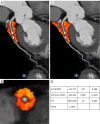Association between coronary plaque vulnerability features and multiparametric pericoronary fat indices on coronary computed tomography angiography: a cross-sectional study
- PMID: 40785932
- PMCID: PMC12332703
- DOI: 10.21037/qims-24-1002
Association between coronary plaque vulnerability features and multiparametric pericoronary fat indices on coronary computed tomography angiography: a cross-sectional study
Abstract
Background: Coronary plaque vulnerability is associated with the fat attenuation index (FAI) of pericoronary adipose tissue (PCAT), but the associations between vulnerability features and multiparametric indices of PCAT remain unclear. In this study, we aimed to explore the effect of four vulnerability features of atherosclerotic coronary plaque on multiparametric indices of PCAT and evaluate the relative responsiveness of these indices in determining the degree of vascular inflammation.
Methods: A retrospective study was conducted on 443 patients clinically diagnosed with coronary artery disease (CAD) at Bozhou People's Hospital from January 2022 to August 2023. The most severely plaque-burdened diseased blood vessels were selected, and plaque vulnerability features, including positive remodeling (PR), low attenuation plaque (LAP), punctate calcification (PC), and napkin-ring sign (NRS), were further evaluated. In addition, quantitative measurements of the multiparametric indices of PCAT centered around the plaque, with a vertical diameter of 40 mm, including FAI, total pericoronary fat volume (FV), perivascular water attenuation index (PVWI), FAI of non-PCAT (non-FAI), and volumetric pericoronary characterization index (VPCI), were performed. They were divided into left anterior descending (LAD)/left circumflex artery (LCx) and right coronary artery (RCA) groups; the indices of PCAT between the two groups were compared using t-test or Mann-Whitney U test. Univariate and multivariate linear regression analyses were conducted to evaluate the associations between vulnerability features, diseased vessels, and PCAT multiparametric indices.
Results: A total of 291 eligible patients were included in this study. Multivariate linear regression analysis revealed that PR, PC, LAP, and NRS were all positively correlated with FAI and non-FAI; PR and LAP were positively correlated with PVWI and VPCI, and negatively correlated with FV (all P<0.05). RCA was negatively correlated with non-FAI and PVWI, and positively correlated with VPCI and FV (all P<0.05). The values of non-FAI and PVWI in the LAD/LCx group (n=210) were higher than those in the RCA group (n=81), whereas FV and VPCI values were lower in the LAD/LCx group (all P<0.05). Multivariate linear regression analysis showed that in the LAD/LCx group, the four vulnerability features were positively correlated with FAI, PC and LAP were positively correlated with non-FAI and VPCI, and negatively correlated with FV value, and PR was positively correlated with PVWI (all P<0.05). In the RCA group, PR, PC, and LAP were positively correlated with FAI, PR, PC, and NRS were positively correlated with non-FAI, LAP was positively correlated with VPCI and PVWI, and PR and LAP were negatively correlated with FV (all P<0.05).
Conclusions: Among the five PCAT indices, the FAI and non-FAI demonstrated stronger associations with plaque vulnerability features, whereas VPCI, PVWI, and FV showed weaker associations. Vulnerable plaque features (PR, LAP) induced more severe inflammatory responses in PCAT compared to PC and NRS. Additionally, PCAT indices were influenced by the lesion-bearing vessel. These findings may guide clinical prioritization of inflammatory biomarkers and refine assessments of plaque-related inflammation severity.
Keywords: Atherosclerotic coronary plaques; computed tomography angiography (CT angiography); pericoronary adipose tissue (PCAT); plaque vulnerability features.
Copyright © 2025 AME Publishing Company. All rights reserved.
Conflict of interest statement
Conflicts of Interest: All authors have completed the ICMJE uniform disclosure form (available at https://qims.amegroups.com/article/view/10.21037/qims-24-1002/coif). The authors have no conflicts of interest to declare.
Figures






Similar articles
-
High-risk plaque features and perivascular inflammation.J Cardiovasc Comput Tomogr. 2025 May-Jun;19(3):299-305. doi: 10.1016/j.jcct.2025.01.010. Epub 2025 Feb 7. J Cardiovasc Comput Tomogr. 2025. PMID: 39922771
-
High levels of pericoronary adipose tissue inflammation are associated with coronary atherosclerosis independent of epicardial adipose tissue volume in patients with chronic coronary syndrome.Eur Heart J Imaging Methods Pract. 2025 Jun 10;3(2):qyaf079. doi: 10.1093/ehjimp/qyaf079. eCollection 2025 Jul. Eur Heart J Imaging Methods Pract. 2025. PMID: 40636778 Free PMC article.
-
Association of Pericoronary Adipose Attenuation With Major Adverse Cardiovascular Events and High-Risk Plaque.JACC Cardiovasc Imaging. 2025 Aug;18(8):884-894. doi: 10.1016/j.jcmg.2025.04.008. Epub 2025 Jul 10. JACC Cardiovasc Imaging. 2025. PMID: 40643422
-
Relationship between pericoronary fat attenuation index and quantitative plaque components in newly identified coronary plaques.Eur J Radiol. 2025 Sep;190:112206. doi: 10.1016/j.ejrad.2025.112206. Epub 2025 May 27. Eur J Radiol. 2025. PMID: 40450797
-
Systematic review of the clinical effectiveness and cost-effectiveness of 64-slice or higher computed tomography angiography as an alternative to invasive coronary angiography in the investigation of coronary artery disease.Health Technol Assess. 2008 May;12(17):iii-iv, ix-143. doi: 10.3310/hta12170. Health Technol Assess. 2008. PMID: 18462576
References
-
- World Health Organization. Disease burden and mortality estimates. WHO: Geneva, Switzerland; 2018.
-
- Yuvaraj J, Lin A, Nerlekar N, Munnur RK, Cameron JD, Dey D, Nicholls SJ, Wong DTL. Pericoronary Adipose Tissue Attenuation Is Associated with High-Risk Plaque and Subsequent Acute Coronary Syndrome in Patients with Stable Coronary Artery Disease. Cells 2021;10:1143. 10.3390/cells10051143 - DOI - PMC - PubMed
-
- Ferencik M, Mayrhofer T, Bittner DO, Emami H, Puchner SB, Lu MT, Meyersohn NM, Ivanov AV, Adami EC, Patel MR, Mark DB, Udelson JE, Lee KL, Douglas PS, Hoffmann U. Use of High-Risk Coronary Atherosclerotic Plaque Detection for Risk Stratification of Patients With Stable Chest Pain: A Secondary Analysis of the PROMISE Randomized Clinical Trial. JAMA Cardiol 2018;3:144-52. 10.1001/jamacardio.2017.4973 - DOI - PMC - PubMed
-
- Sun JT, Sheng XC, Feng Q, Yin Y, Li Z, Ding S, Pu J. Pericoronary Fat Attenuation Index Is Associated With Vulnerable Plaque Components and Local Immune-Inflammatory Activation in Patients With Non-ST Elevation Acute Coronary Syndrome. J Am Heart Assoc 2022;11:e022879. 10.1161/JAHA.121.022879 - DOI - PMC - PubMed
LinkOut - more resources
Full Text Sources
Research Materials
Miscellaneous
